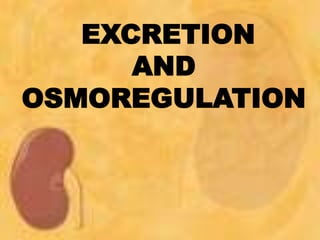
Excretion and osmoregulation(1)
- 2. 1. OSMOREGULATION AND EXCRETION • Relative concentrations of water and solutes must be maintained within fairly narrow limits • Osmoregulation regulates solute concentrations and balances the gain and loss of water. • Freshwater animals show adaptations that reduce water uptake and conserve solutes
- 3. OSMOREGULATION AND EXCRETION • Desert and marine animals face desiccating environments that can quickly deplete body water. • Excretion gets rid of nitrogenous metabolites and other waste products.
- 4. OSMOREGULATION OF MARINE BONY FISH • Marine bony fishes are hypoosmotic (have less solutes/salt than) to sea water. • They loose water by osmosis and gain salt by diffusion and from food. • They balance water loss by drinking seawater and excreting salts
- 5. OSMOREGULATION OF MARINE BONY FISH
- 6. OSMOREGULATION OF FRESH WATER FISH Freshwater animals constantly take in water by osmosis from their hypoosmotic environment They lose salts by diffusion and maintain water balance by excreting large amounts of dilute urine Salts lost by diffusion are replaced in foods and by uptake across the gills
- 7. OSMOREGULATION OF FRESH WATER FISH
- 8. 2. WASTE PRODUCTS UREA AMMONIA URIC ACID The kinds of nitrogenous wastes excreted depend on an animal’s evolutionary history and habitat The amount of nitrogenous waste is coupled to the animal’s energy budget
- 9. AMMONIA Form when an amino group (NH2) adds a third hydrogen ion. = NH3. Ammonia is rather toxic. If enough water is available to wash it from the body it can be a nitrogenous excretory product. Do not require a lot of energy for production. Ammonia is excreted by most fish whose gills and skin are in direct contact with the water of the environment.
- 10. UREA Requires a lot of energy for production of Urea. Carrier molecules take up carbon dioxide and 2 molecules of ammonia to form and excrete urea. Urea is less toxic than ammonia. Can be excreted as a concentrated solution. – Important allows terrestrial animals to conserve water. Sharks, frogs and mammals excrete urea as their main nitrogenous waste.
- 11. URIC ACID Requires an extreme amount of ATP (energy) for the production of Uric acid. Uric acid is not very toxic and do not dissolve in water readily, therefore is excreted very concentrated – to conserve water in the body. Uric acid is routinely excreted by insects, reptiles and birds.
- 12. 3. EXCRETORY ORGANS AMONG INVERTEBRATES Most animals have tubular excretory organs that regulate the water-salt balance of the body and excrete metabolic wastes into the environment. 3 examples amongst invertebrates: Planarians – use Flame cells. Earthworms – use Nephridia. Insects – use Malpighian tubules. On occasion, excretion also involves other organs, such as the rectum in the earthworm and the gills in crayfish.
- 13. PLANARIANS (FLATWORMS)with flame cells Flatworms use flame cells (bud-like outgrowths in a branched tubular excretion system) with cilia to filter out waste and get rid of excess water.
- 14. Earthworm with nephridia Earthworms have nephridia with a ciliated opening, called the nephridiostome, that leads to a coiled tubule surrounded by blood capillaries. Waste move through the tubules and is excreted through the nephridiopore.
- 15. Insects with Malpighian tubules Insects use thin tubules called Malpighian tubules attached to the gut for excretion
- 16. 4. HUMAN EXCRETORY ORGANS Humans use several excretory organs: Lungs – Carbon dioxide (waste product from cellular respiration) Kidneys and bladder - Ammonia, uric acid, excess water, excess salt and urea (Waste products in deamination and food) Liver - Colorants, alcohol, poisons(Waste products from food and drink) Alimentary canal - Feaces (undigested food), cellulose. Skin - Excess water and salt, ammonia.
- 17. 5. HUMAN URINARY SYSTEM Consist of paired kidneys, renal artery, renal vein, ureter, bladder and urethra. Each kidney is supplied with blood by a renal artery (impure, oxygenated blood) and drained by a renal vein (pure, deoxygenated blood). Urine exits each kidney through a duct called the urether. Both urethers drain into a common urinary bladder, and urine is expelled through a urethra.
- 19. STRUCTURE OF A KIDNEY The mammalian kidney has two distinct regions: an outer renal cortex and an inner renal medulla
- 20. STRUCTURE OF A KIDNEY
- 21. REFERENCES Biopharmaceutics and Pharmacokinetics , II edition 2005, Birla Publication Pvt.Ltd, https://www.slideshare.net/PinkeshPatel1/excretion-10212619, accessed in November 2011
